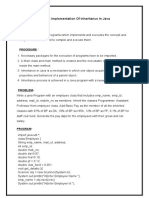Basics of Java Programming
Uploaded by
Prasoon SinghBasics of Java Programming
Uploaded by
Prasoon SinghInt Programming--Malone
Basics of Java Programming
(A Work In Progress) What Constitutes a Java Program? A Java program consists of one or more source files. Each source file is called <class name>.java, where <class name> is the name of the class contained in that source file and .java is the extension that identifies the file as a Java source code file. In general, each source file contains one class. The name of the class must match the name of the file (without the extension) exactly. To execute a Java program, you first need to compile the source code into byte code. Byte code files have the name <class name>.class. If youre working from the shell, this is done using the javac command (where c is for compiler). Usually we will be compiling using the Xcode IDE. Once compiled, the program is executed using the Java interpreter (a.k.a. the Java Virtual Machine or JVM). From the shell, the JVM is invoked with the java command. Again we will usually be doing this with the Build and Go or Debug options of the Xcode IDE. A Java program must have a routine called main(), which is the starting point for program execution. main() will always look something like this: public static void main (String args[]) { // insert code here... System.out.println("Hello World!"); } Source Code Formatting Keep in mind the following when writing Java source code: Java is case sensitive (foo, Foo, and fOO are all considered to be different in Java). Every line of code in Java must end in a semi-colon (;). Java doesnt care about white space (line breaks, tabs, etc.) but consistent and thoughtful use of white space makes code much easier to read and is part of good programming style. You can create comments in Java using // for a single-line comment or /* */ for a block comment. Examples: // This comment is just this one line /* This comment includes many lines. Code inside is inactive (commented out) int x; x = 5; */
Basics of Variables and Assignment Like almost every programming language, Java has variables and an assignment statement to put values into a variable. There are two classifications of variables in Java: primitive types and reference variables. The primitive types we are interested in are int, double, and Boolean, for integer, floating point, and true/false values respectively. An example of declaring and assigning to primitive types: int x; x = 3; double y; y = 0.3; boolean b; b = (x < y); // // // // // // // declare an integer variable x assign the value 3 to x declare a floating point variable y assign the value 0.3 to y declare a boolean variable b b will be assigned false, because the expression x < y evaluates to false
A reference variable either points to an object or is null (null is a keyword for a reference variable that is empty). An example of declaring and using reference variables: Foo f1; Foo f2; f1 = new Foo(Im a foo!); // create a new Foo and have f1 // point to it f2 = f1; // f2 now points to the same Foo as f1 f1 = null; // now f1 doesnt point to anything but // f2 still points to the Foo created before
Basics of Classes Java is an object-oriented programming (OOP) language and the fundamental unit for organizing code is the class. A class has properties (a.k.a. member data) which contain characteristics and data (in general, nouns or adjectives) and methods (code) for actions (verbs). Properties and methods together are called, collectively, members. Here is an example of a partial class for holding a complex number in rectangular form. public class RectComplexNumber { double a; // the real part of the complex number double b; // the complex (i) part of the complex number // constructorcreate a new complex number with given values public RectComplexNumber(double aInput, double bInput) { a = aInput; b = bInput; } // add this complex number to addend and return the result public RectComplexNumber add(RectComplexNumber addend) { return new RectComplexNumber(a + addend.a, b + addend.b); } // etc. }
Using Built-In Classes and Packages The Java Developers Kit (JDK) comes with a huge amount of built-in Java code that can be used to build applications. However, for a Java class to use this code it must identify the package that contains that code. This is done at the top of the source file using the import keyword. Example: import java.util.*; import java.io.File; Public vs. Private Like all OOP languages, Java has mechanisms to support encapsulation. In general, we declare as public all properties and methods we want code outside our package to use. Otherwise the default is that all code in the same package can access the members. If we only want the code in that particular class to access members, we declare them as private. Good encapsulation style suggests that all properties have non-public or private access. In other words, the outside world should only be able to access or modify properties by calling methods. There, are, however, exceptions. Basic Flow of Control There are two main flow-of-control constructs: branches (if-then) and loops. The Java syntax for a branch is if (x > 10000) { System.out.println(x is big!); } else if (x > 100) { System.out.println(x is medium.); } else { System.out.println(x is small.); } Note that the code inside the curly brackets for each if or else can be arbitrarily complex and thus might contain additional branches. // // // // gain access to all the code in the java.util package (* means all) gain access to the File class of the java.io package
Below is a code fragment that illustrates the basic Java syntax for a loop: int i; // loop variable int total; // accumulator // this loop adds up the integers from 1 to MAX for ( i = 1; i++; i <= MAX) { total = total + i; }
You might also like
- Java: Programming: Your Step by Step Guide to Easily Learn Java in 7 DaysFrom EverandJava: Programming: Your Step by Step Guide to Easily Learn Java in 7 Days4/5 (30)
- BIT205-HO1-Basic Concepts of JAVA ProgrammingNo ratings yetBIT205-HO1-Basic Concepts of JAVA Programming73 pages
- Java Basic structure, Identifiers, Data types and OperatorsNo ratings yetJava Basic structure, Identifiers, Data types and Operators8 pages
- Handout 2 Introduction To Java Programming LanguageNo ratings yetHandout 2 Introduction To Java Programming Language33 pages
- Object Oriented Programming with Java (1)No ratings yetObject Oriented Programming with Java (1)17 pages
- Introduction To Java and Object-Oriented ProgrammingNo ratings yetIntroduction To Java and Object-Oriented Programming11 pages
- Java Lab Sessions-CSL 201: 1 Intro 2 (3 4)No ratings yetJava Lab Sessions-CSL 201: 1 Intro 2 (3 4)20 pages
- Object Oriented Programming 2nd Year Computer & System Engineering DepartmentNo ratings yetObject Oriented Programming 2nd Year Computer & System Engineering Department52 pages
- Csc201 Introduction To Programming Csc201 Futo 2020No ratings yetCsc201 Introduction To Programming Csc201 Futo 202012 pages
- Career Summary: Fi Planning (Deployment& Optimization), RF Optimization, Network Quality, in GSMNo ratings yetCareer Summary: Fi Planning (Deployment& Optimization), RF Optimization, Network Quality, in GSM1 page
- One Dimensional Array in Java - Tutorial & ExampleNo ratings yetOne Dimensional Array in Java - Tutorial & Example4 pages
- Cambridge IGCSE™: Computer Science 0478/22No ratings yetCambridge IGCSE™: Computer Science 0478/2216 pages
- Software Development Models: Waterfall ModelNo ratings yetSoftware Development Models: Waterfall Model8 pages
- C5: Copenhagen Comprehensive C# Collection Classes and Experience With Generic C#No ratings yetC5: Copenhagen Comprehensive C# Collection Classes and Experience With Generic C#35 pages
- EVB - PSF - MLX90640: Product Specific Function Description Software LibraryNo ratings yetEVB - PSF - MLX90640: Product Specific Function Description Software Library39 pages
- EX No: 6 Implementation of Inheritance in Java: ProcedureNo ratings yetEX No: 6 Implementation of Inheritance in Java: Procedure4 pages
- PSP2 Design Review Checklist: Purpose GeneralNo ratings yetPSP2 Design Review Checklist: Purpose General2 pages
- Online Hostel Management System ProjectNo ratings yetOnline Hostel Management System Project16 pages
- Vba To VB - Net XLL Add in With Excel DnaNo ratings yetVba To VB - Net XLL Add in With Excel Dna51 pages































































































